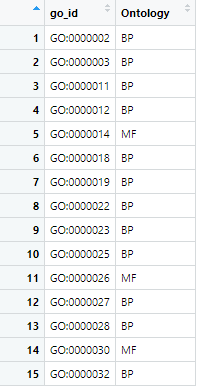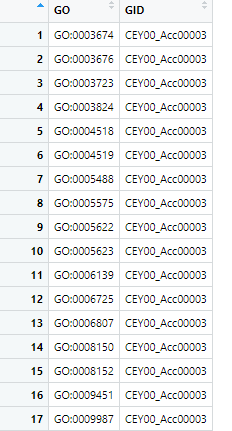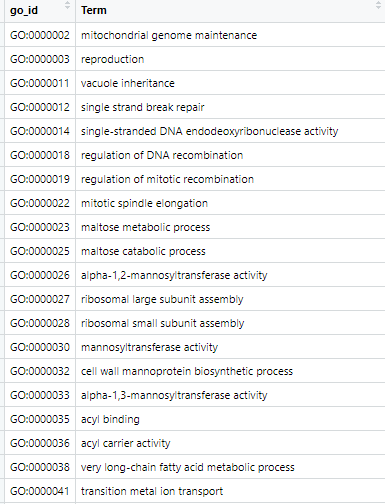clusterProfiler |给 enricher() 和 enrichGO() 写个弟弟——enricherGO()
介绍
clusterProfiler 包中的两个富集函数enricher() 和 enrichGO() ,都可以做GO的差异富集,前者更加通用,后者功能更加完善。
前者的通用是它能用于非模式生物的GO与KEGG,后者完善是其结果能直接用于clusterProfiler::simplify() 。
Y叔并没有让enricher() GO富集结果能直接用于clusterProfiler::simplify() ,感兴趣的自己去试下。
我做的是非模式生物,但是我还想用clusterProfiler::simplify() ,所以我在enricher() 基础上给 enricher() 和 enrichGO() 写个弟弟——enricherGO() 。其结果保留了R包"DOSE" 中定义的"enrichResult" 类。代码只是能运行,运行不一定就正确,慎用!慎用!
准备数据
准备输入数据go2ont , go2gene, go2term和 DEG_DESeq2
go2ont 可由clusterProfiler::go2ont() 获取。

go2gene 是你的注释结果,内容如下:
第二列为所有gene,这里巧合了,截图部分只有一个gene。

go2term 可由clusterProfiler::go2term() 获取。

DEG_DESeq2 是我的上下调基因结果,行名为差异基因ID,此处示例随机选取了我实际数据的60个基因展示(此处不做展示)。
使用
我写的enricherGO() 除go2ont与ont 参数外,均与enricher() 相同。
ont 与enrichGO() 相同。"BP", "MF", "CC", "ALL" 之一。如果你下面提供的go2ont 中只有一种Ontology ,如BP,即使你在函数中指定ont = "ALL" ,函数内部也会将ont 强制命名为BP。
函数内部运行不管你选哪种ont,其实都是先以ALL分析完,如果你的ont 为"BP", "MF", "CC" 则会进行再次筛选。
go2ont 可以由go2ont() 获取。这个参数也可以不指定,此时将利用clusterProfiler从网络获取数据。不过强烈建议提前准备好,不然每次运行函数都下载一次,不知道会不会封你IP呀。
这个参数我猜测应该有更高级的写法,比如可以第一次运行时获取,再次运行时则在现有变量中搜索这个变量名称。当然,这只是我瞎猜的,不确定是否有这种写法。mark一下,回头有机会再来尝试。
其实这里写的时候我有点犹豫,当指定的go2ont 与ont 可能冲突时可以有两种选择,我选择是以go2ont 为准,另一种方式是以ont =ALL 为准。反正函数就明明白白摆在这里,大家跟我选择相左可以自己修改。
1
2
3
4
5
6
7
8
9
10
11
12
13
14
15
16
17
18
19
20
21
22
23
24
25
26
27
|
library(BioUncle) #我自己的R包。# devtools::install_github("zhengshimao/BioUncle")
library(clusterProfiler)
library(dplyr)
library(tidyr)
go_results3 <- enricherGO(gene = rownames(DEG_DESeq2_ALL_DH_12h_vs_DH_0h),
go2ont = go2ont,
pvalueCutoff = 1,
ont = "ALL",
pAdjustMethod = "BH",
qvalueCutoff = 1,
TERM2GENE = go2gene,
TERM2NAME = go2term)
class(go_results3)
## [1] "enrichResult"
## attr(,"package")
## [1] "DOSE"
class(go_simplfy3)
## [1] "enrichResult"
## attr(,"package")
## [1] "DOSE"
dim(go_results3@result)
## [1] 508 10
go_simplfy3 <- clusterProfiler::simplify(go_results3)
dim(go_simplfy3@result)
## [1] 267 10
|
可以清楚看到结果中GO词条减少了。
1
2
3
4
5
6
7
8
9
10
11
12
13
14
15
|
go_results2 <- enricherGO(gene = rownames(DEG_DESeq2_ALL_DH_12h_vs_DH_0h),
go2ont = go2ont,
pvalueCutoff = 1,
ont = "MF",
pAdjustMethod = "BH",
qvalueCutoff = 1,
TERM2GENE = go2gene,
TERM2NAME = go2term)
unique(go_results2@result$ONTOLOGY)
## [1] "MF"
go_simplfy2 <- clusterProfiler::simplify(go_results2)
unique(go_simplfy2@result$ONTOLOGY)
## [1] "MF"
|
函数
1
2
3
4
5
6
7
8
9
10
11
12
13
14
15
16
17
18
19
20
21
22
23
24
25
26
27
28
29
30
31
32
33
34
35
36
37
38
39
40
|
enricherGO <- function(gene,
go2ont = NULL,
pvalueCutoff,
qvalueCutoff = 0.2,
pAdjustMethod = "BH",
universe,
minGSSize = 10,
maxGSSize = 500,
TERM2GENE,
TERM2NAME = NA
){
# go2ont
if(is.null(go2ont)){
message("Downloading……\nGO2Ontology table.")
go2ont = clusterProfiler:::get_GO2Ontology_table() # devtools::check() warning!
}else{
go2ont = as.data.frame(go2ont)
names(go2ont) <- c("go_id","Ontology")
message("GO2Ontology: Ready!")
}
# enricher
go_result <- clusterProfiler::enricher(
gene = gene,
pvalueCutoff = pvalueCutoff,
pAdjustMethod = pAdjustMethod,
qvalueCutoff = qvalueCutoff,
minGSSize = minGSSize,
maxGSSize = maxGSSize,
TERM2GENE = TERM2GENE,
TERM2NAME = TERM2NAME)
go_result@ontology <- "GOALL"
# change the order of colnames
go_result@result <- go_result@result %>% dplyr::left_join(go2ont,by = c("ID" = "go_id")) %>% dplyr::select(10,1,2,9,3:8) %>% dplyr::arrange(pvalue) %>% tidyr::drop_na()
# rename,mkae it same to the result of enrichGO function.
colnames(go_result@result)[1] <- "ONTOLOGY"
return(go_result)
}
|
小结
感谢Y叔,感谢Y叔写simplify函数时的手下留情,不过以后多照顾下我们非模式生物那就更好了。
代码只是能运行,运行不一定就正确,慎用!慎用!


